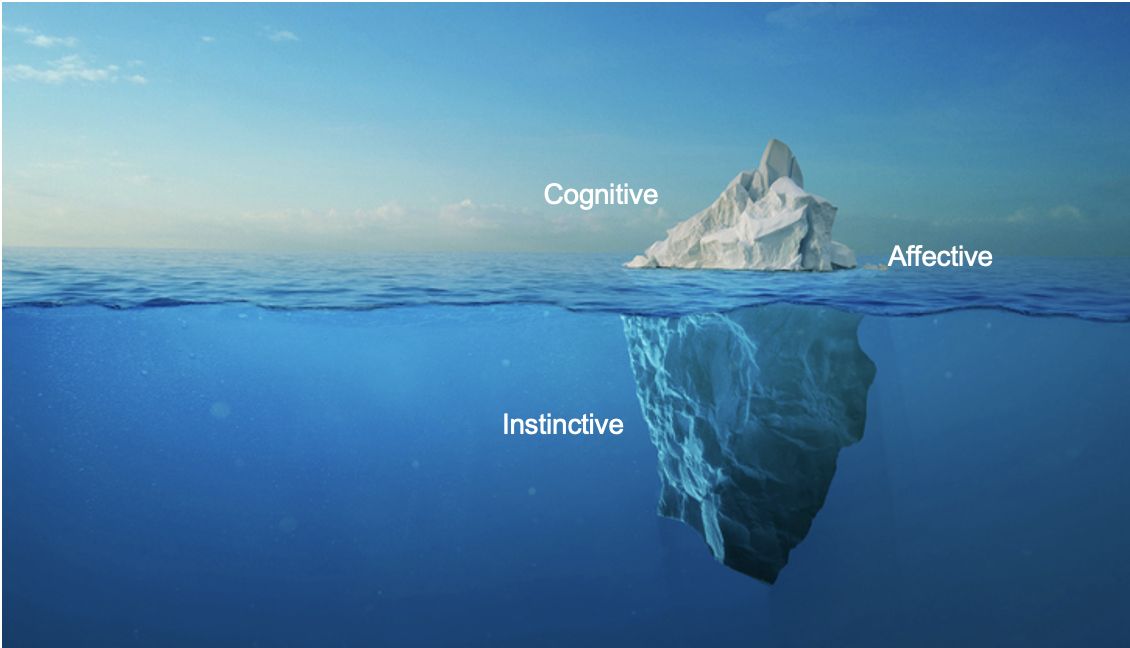
A Technology Leadership Team hired me to facilitate a team dynamics workshop on the first day of their 3-day offsite.
Eleven R&D leaders in a division of a Fortune100 company, mostly (software) engineers.
New team leader. Lots of tensions.
3D Intelligence
Working with teams, it’s important to understand their Cognitive, Affective, and Instinctive intelligences.
Cognitive indicates knowledge, skills, and experience, what’s on a resume or indicated by a job title…these are visible “above the surface.” In addition to the Head of R&D, this leadership team included Customer Support Leaders, Project Portfolio Leaders, a System Test Manager, and others.
Affective includes emotions, values, and personality. We’ve all experienced within ourselves, and witnessed in others, when emotions burst above the water line and impact our interactions with others. When teams are new, or have a new leader, trust (affective) often takes time to build.
Instinctive intelligence measures action-based strengths…how we invest our time and energy to seek possibilities and solve problems. It provides a robust view of what’s happening beneath the surface, what’s driving people’s actions and interactions.
There’s more information on these intelligences in my 2016 article, Conflicts and Silos and Teams, oh my.
Lurking Below The Surface
The Kolbe assessment I invited the leaders to complete in advance of our workshop revealed the source of several challenging dynamics within this Technology Leadership Team.
The implications of having a team full of engineers was aligned with my expectations but a surprise to them.
It revealed the conflicts, blind spots, and inertia on the team and offered clues to map the path forward to address them.
Culture Of Engineers = Culture Of Experts
Engineers frequently have the profile of an “expert.” Ten of the eleven leaders were deep dive fact finders.
They research and share information with specificity and nuance, they pay attention to precedence.
While this can impact personality or behavioral styles (Affective,) we were measuring how they invest their time and energy, naturally or instinctively.
Complexity Over Simplicity
The expertise of engineers is usually a strength in their role but can wreak havoc on team dynamics.
It can be the source of inertia as well as leave a critical blind spot for translating complexity into simplicity…for customers, decision makers, etc.
Symptoms Of A Team Of Experts
Analysis Paralysis.
The most common challenges on teams of “fact-finding experts” include long, and often unproductive, meetings driven by in-depth analyses and debates over facts, theory, reason or experience.
The inertia in fact finding, specificity, and historical precedence is the most common pattern I see on teams.
This is true not only for technology teams but cross-functional leadership teams as well.
Creativity & Innovation
Another characteristic common among engineers (with exceptions!) is to minimize risk and uncertainty. They tend to drive incremental improvement and refinement, to assure quality. Which is valuable if it aligns with the team’s objectives.
Seven of the eleven leaders on this Technology Leadership Team were hardwired to instinctively minimize risk and uncertainty rather than lean into new possibilities.
Collectively, that can create team dynamics that resist change and rely on close-in solutions that are perceived as safer.
This underlying pattern, often lurking beneath the surface on technology and leadership teams, can thwart their need for creativity and innovation.
The Value Of Outliers
Only one leader on the team instinctively leaned into brainstorming solutions that have never been tried before rather than looking to historic precedent.
She instinctively worked with greater speed and brought a sense of urgency to the team.
Cultures of engineers often reject these valuable strengths, judging them as risky or reckless. Yet they add diversity of strengths that can have a significant positive impact on the speed and productivity of teams.
I don’t have enough data to prove a broader pattern, yet, but Agile Coaches I’ve worked with tend to be wired as Outliers which makes an important contribution to their teams.
What Are Your Technology Or Leadership Team Dynamics?
As you think about 3D Intelligence and what might be lurking beneath the surface of your team dynamics, what are you seeing and learning?